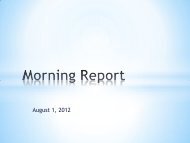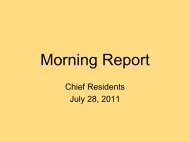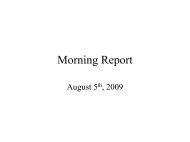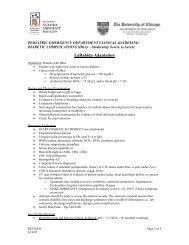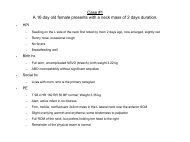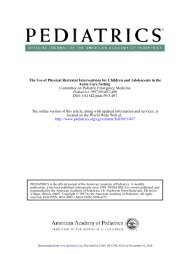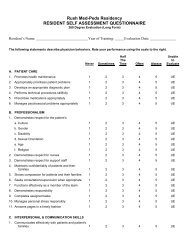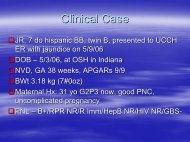Carbon Monoxide Poisoning
Carbon Monoxide Poisoning
Carbon Monoxide Poisoning
You also want an ePaper? Increase the reach of your titles
YUMPU automatically turns print PDFs into web optimized ePapers that Google loves.
<strong>Carbon</strong> <strong>Monoxide</strong><br />
<strong>Poisoning</strong><br />
Morning Report<br />
January 7, 2009
Sources of <strong>Carbon</strong> <strong>Monoxide</strong><br />
Car exhaust fumes (#1 cause of CO-related death)<br />
Smoke from fires (#2)<br />
Furnaces<br />
Gas-powered engines (idling boats)<br />
Home water heaters<br />
Wood stoves/ gas stoves/ space heaters<br />
Paint removers (containing methylene chloride)<br />
Tobacco smoke<br />
Pool heaters
Pathophysiology<br />
Curve shifts LEFT<br />
O2 delivery to tissues<br />
…Tissue hypoxia ensues
Historical Clues<br />
Co-inhabitants with similar symptoms at same onset<br />
Symptoms recur and do not follow a regular 7-10<br />
day viral course<br />
Alternative heating devices (space heaters, gas<br />
stoves), wintertime (idling auto with snow blocked<br />
exhaust pipe)<br />
Improves when away from site<br />
Absence of sore throat/fever/URI symptoms<br />
Illness or death of a family pet
Environmental Exposure History<br />
Community (urban vs.rural/near industrial sites)<br />
Home (heating sources, location of bedrooms,<br />
fireplaces, wood stoves)<br />
Hobbies (especially hockey, ice skating)<br />
Occupation (industrial sites w/ inadequate<br />
ventilation, auto repair shops, loading docks)<br />
Personal (screen for depression/suicidal ideation)<br />
Diet<br />
Drugs (especially tobacco)
Clinical Presentation<br />
COHb 20%<br />
Headache<br />
Dizziness<br />
Weakness/myalgia<br />
Nausea/vomiting<br />
Shortness of breath<br />
Visual changes<br />
Chest pain<br />
COHb >40%<br />
Confusion<br />
Syncope<br />
Pulmonary edema<br />
Coma<br />
Seizures<br />
COHb >60%<br />
Cardiac ischemia<br />
Death<br />
Classic Triad “cherry red lips,<br />
cyanosis & retinal hemorrhages”<br />
Delayed Neuropsychiatric Syndrome<br />
Delayed onset of neurologic symptoms after apparent<br />
recovery from acute CO intoxication<br />
Occurs 3-240 days (mean 20) in up to 50% of patients<br />
The development of DNS correlates poorly with COHb levels<br />
Symptoms: cognitive and personality changes, parkinsonism,<br />
dementia, psychosis, movement disorders<br />
Imaging will often show abnormalities within the globus<br />
pallidus and the deep white matter<br />
Recovery occurs in 50-75% of affected persons within one<br />
year
Diagnosis<br />
Carboxyhemoglobin level<br />
Measured directly via co-oximetry<br />
A low level does not rule out acute intoxication<br />
ABG- metabolic acidosis (and co-oximetry)<br />
PaO2 may be normal!<br />
BMP- anion gap metabolic acidosis<br />
EKG
Management<br />
100% O2<br />
Half-life of COHb :<br />
Room air: 4-5 hrs<br />
100% oxygen: 90 min<br />
Hyperbaric oxygen: 20-30 min<br />
Ventilatory support if needed<br />
Cardiac monitoring<br />
Most CO poisonings can be managed in the ED<br />
COHb levels >25% admission is recommended
Hyperbaric Oxygen Therapy<br />
HBO involves exposure to 100% FiO2 under supraatmospheric<br />
conditions (2.5-3.0 atm)<br />
May be beneficial in preventing the late<br />
neurocognitive deficits (DNS)<br />
Results of clinical trials vary widely<br />
Most authorities recommend HBO if:<br />
COHb >30%<br />
LOC, acute neurological deficits<br />
Pregnant women with COHb >15%
Take Home<br />
CO poisoning results in nonspecific sx…HA,<br />
dizziness, weakness, N/V<br />
SaO2 and PaO2 may be normal…
References<br />
Abelsohn, A, Sanborn MD., Jessiman, BJ. Identifying and managing<br />
adverse environmental health effects: <strong>Carbon</strong> monoxide poisoning.<br />
CMAj. 2002; 166 (13): 1685-1690<br />
Armin Ernst, MD and Joseph D. Zibrak, MD. <strong>Carbon</strong> <strong>Monoxide</strong><br />
<strong>Poisoning</strong>. NEJM 1998; 339:1603-1608.<br />
Juurlink DN, Stanbrook MB, McGuigan MA. Hyperbaric oxygen for<br />
carbon monoxide poisoning. Cochrane Database Syst Rev 2005; 1:<br />
CD002041<br />
Weaver LK, et al. Hyperbaric oxygen for acute carbon monoxide<br />
poisoning. NEJM 2002; 347: 3. Reviewed in: The Peds CCM Evidence-<br />
Based Journal Club, 2003.



